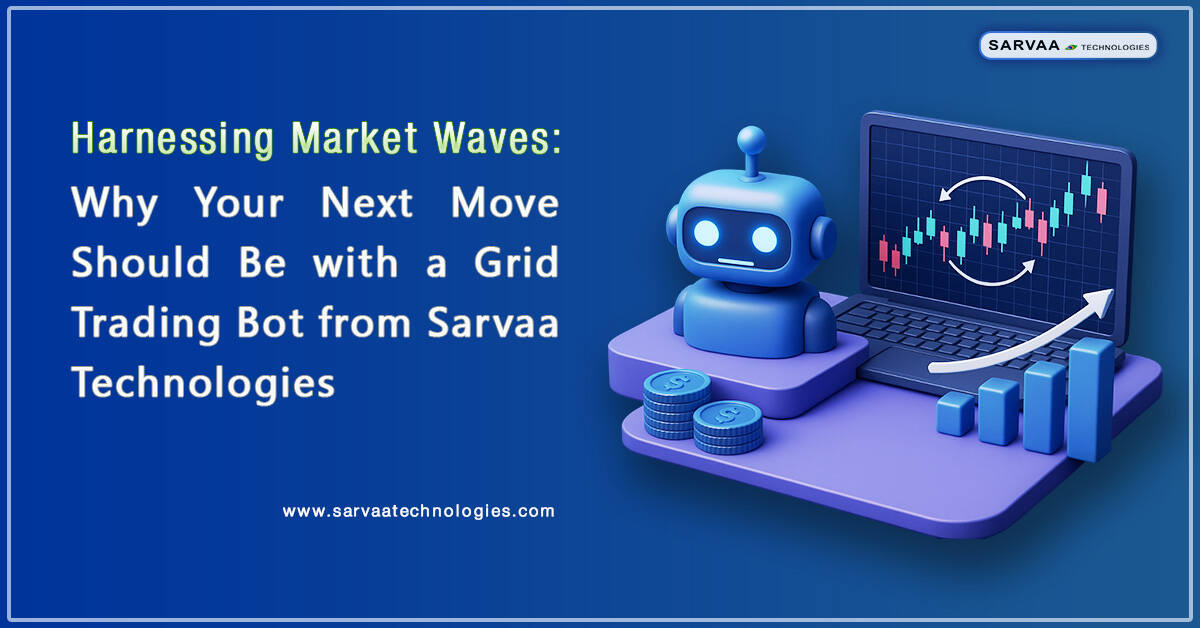Why Grid Trading Bots Now?
Market behavior in 2025 has become a different beast altogether: faster swings, unpredictable sentiment cycles, and round-the-clock trading windows across crypto, forex, and futures. For many traders and businesses, this pace is exciting but nearly impossible to manage manually.
That’s where grid trading bots are stepping into the spotlight, and why more decision-makers are leaning toward automated strategies as they prepare for 2026.
A grid trading bot thrives in exactly the kind of volatility we are seeing today. Instead of trying to time the “perfect” entry, the bot works within a defined price range and keeps placing buy and sell orders at multiple levels. Each small movement in the market becomes an opportunity.
When markets dip, the bot buys. When they rise, it sells. And it does this repeatedly without emotional bias, fatigue, or hesitation.
For businesses exploring automation or traders wanting consistency, this approach offers something rare: stability in motion. While other strategies demand constant monitoring, a grid bot quietly works in the background and turns fluctuations into structured profit cycles.
Thus, Grid Trading Bots are one of the most effective ways to handle today’s dynamic trading environment. The demand is growing, because it has become a practical solution for markets that refuse to slow down.
As we look toward 2026, the importance of automation will only increase, and grid strategies will continue to be a reliable tool for navigating uncertain price movements.
This blog will break down what grid bots truly are, how they work, and how we build them in a way that fits real-world trading needs without complexity.
What Is a Grid Trading Bot and How It Works
A grid trading bot is built around a simple and powerful idea: the market doesn’t move in a straight line. Prices rise, fall, bounce, and repeat. Instead of fighting that natural rhythm, a grid bot uses it to your advantage by placing a series of buy and sell orders across a preset price range. This range is divided into multiple levels of your “grid.” Each level acts as a checkpoint where the bot automatically executes a trade whenever price crosses it.
Here’s the beauty of it: you don’t need to predict the next big breakout or identify a perfect trend. As long as the price keeps moving within your chosen range, the bot continues to work. When the market dips to a lower grid level, it buys. When it climbs to a higher grid level, it sells. Profit gets locked in through many small trades instead of waiting for one big move.
This approach is particularly useful in markets that experience frequent but manageable volatility like crypto pairs, forex majors, and even futures contracts. Traders who prefer steady returns over risky bets often find grid trading more comforting and predictable.
Another advantage is the discipline it enforces. Emotions, panic buying, hesitation, and revenge trades never enter the picture. The bot sticks to the system you set. This alone helps many traders avoid their most expensive mistakes.
Later in this blog, we’ll explore how strategies differ between spot, futures, and multi-market environments. But at its core, a grid trading bot is a structured, rule-based system that takes the chaos of fast-moving markets and turns it into a series of repeatable opportunities.
Why Businesses and Traders Choose Sarvaa Technologies for Grid Trading Bot Development
Most people who reach out to us usually come with a story: maybe they tried those ready-made bots floating around online, or perhaps they experimented with marketplace scripts that worked well for a week and then fell apart the moment the market became unpredictable. What they really want is something steady, transparent, and shaped around the way they trade. That’s where Sarvaa Technologies naturally fits in.
Instead of jumping straight into development, we spend time understanding the person or business behind the request. Some traders like slow, methodical grids on spot markets. Others enjoy the fast pace of futures. A few want a system that quietly compounds profits while they focus on other work. Each style demands a slightly different structure, and we design the bot around that, not the other way around.
Our experience in building broader automated trading systems helps as well. Over time, we’ve seen what makes a bot dependable and what causes it to stumble when the market becomes harsh. That insight makes a big difference, especially now, when 2025’s volatility leaves no room for half-done solutions.
Another reason people choose us is the way we treat the project after development. A grid bot is not something you build once and walk away from. Markets change. Price behavior changes. Your goals might change too. So we keep room for updates, adjustments, performance checks, and honest discussions about what’s working and what needs a tweak.
In short, clients come to us for a grid bot development with a team that actually listens, builds responsibly, and stays involved long after the bot goes live.
Key Features of a Best-in-Class Grid Trading Bot
A well-built grid trading bot’s real strength lies in the details of the small but essential features that allow the bot to stay consistent even when the market throws its usual surprises.
When people talk about the “best grid trading bots,” they’re often referring to systems that can operate smoothly without demanding constant supervision. That’s exactly what a strong grid bot aims to deliver.
- The first thing users usually look for is multi-exchange flexibility. Many prefer trading on platforms like Binance, while others work with different exchanges or even split their strategies across several of them. A good grid bot should handle that without friction.
- Spot markets,
- futures markets,
- or mixed setups
The bot must understand the nature of each environment and execute trades accordingly.
- Risk control is another crucial element. Markets can be friendly one day and ruthless the next. A robust system needs built-in protection:
- adjustable grid levels,
- safety orders,
- clear rules for capital limits,
and a way to prevent unexpected exposure when volatility suddenly expands.
These controls keep the bot grounded even when traders are away from their screens.
- Then comes performance logic. Markets evolve quickly, especially as we step into 2026, so a bot cannot rely solely on fixed parameters. It must adapt whether that means
- shifting grid spacing,
- adjusting trade sizes,
- or pausing during extreme spikes.
Subtle improvements like these often make the difference between a bot that survives and a bot that thrives.
- Lastly, ease of use matters more than people admit.
- Clean dashboards,
- simple settings,
- readable analytics
These things help traders focus on decisions, not technical confusion.
When all these features come together, the result is a grid bot that feels reliable, controlled, and genuinely helpful in day-to-day trading.
Grid Trading Bot Strategy: Spot, Futures & Cross-Market Considerations
Every trader eventually discovers that grid trading shifts its personality depending on the market you use it in. A grid running on a simple spot pair behaves very differently from one operating inside a futures environment. Understanding these differences helps you choose the right approach instead of forcing one model to fit every market.
Spot grids are usually the starting point for most traders. They’re steady, straightforward, and ideal for those who prefer controlled accumulation. Here, the bot buys lower, sells higher, repeats the cycle, and gradually builds profit as long as the price stays within your chosen range. The appeal is simplicity. There’s no leverage, no liquidation risk, and no pressure to monitor every sudden spike.
Futures grids, on the other hand, move at a faster rhythm. They add leverage into the mix, which means opportunities open up more quickly but mistakes can also grow faster if not handled carefully. A good futures grid strategy pays close attention to spacing, funding fees, and market direction. Some traders use it for continuous scalping. Others run wider grids during periods of sideways movement. Either way, precision matters more here than in spot trading.
Then there’s the multi-market approach, where traders spread their grids across different asset types: crypto, forex, or even commodities. This style helps reduce overexposure to a single trend and offers more consistent opportunities. But it also requires a bot that understands each market’s unique behavior.
In Sarvaa Tech, we map out these distinctions before writing a single line of code. A grid bot becomes truly effective only when it mirrors the environment it trades in.
Implementation Approach: How Sarvaa Builds and Delivers Your Grid Bot
Whenever someone asks us how we build a grid trading bot, we usually say the same thing: the process starts long before any coding happens. A good bot cannot be just a software; it’s a reflection of how you think about the market.
So, the first step is always a detailed conversation. We try to understand your trading habits, if business, yes its ideas and features to implement, the audience markets of interest, risk comfort, and the kind of results you hope to see. This early clarity saves a lot of trouble later.
Once the strategy is clear, we translate it into a structure the bot can follow. This includes
- defining the grid range,
- Spacing,
- order size logic,
- safety rules,
and how the bot should react when the market behaves unpredictably.
We also check whether the strategy fits spot, futures, or a mix of both. This planning phase is usually where the strategy becomes sharper, because small adjustments can make a huge difference to long-term performance.
After that, the development stage begins. Here, our team builds the actual bot clean architecture, strong API handling, smooth order execution, and all the guardrails needed to keep the bot safe on a live exchange.
Before anything goes live, we run multiple rounds of backtesting and simulations. This helps you see how the bot would have behaved during past market cycles instead of relying on guesswork.
Deployment comes next, where we set up your bot on the exchange of your choice and walk you through the dashboard, controls, and monitoring tools. But our involvement doesn’t stop there. Markets evolve, and strategies age, so we stay available for tweaks, updates, and performance reviews whenever needed.
By the time your bot is running, it feels less like a tool we built and more like a system built around you.
Security, Compliance & Future-Proofing in the Grid Bot Space
Whenever someone thinks about building a trading bot, the first thing that comes to mind is usually performance, how much the bot can earn or how well it handles volatility. But in real trading, especially with automated systems, the quieter responsibilities matter just as much.
Security, for example, isn’t the kind of thing you notice when everything is working, but it becomes the only thing you care about the moment something goes wrong.
One of the first steps we take is making sure the bot connects to the exchange in a safe, controlled way. API keys are treated with the same care you’d give to your bank login.
They’re encrypted, stored away from casual access, and, most importantly, set with restrictions so the bot can never withdraw funds. Even if someone tried to misuse the keys, there’s nothing they could actually take. That single limitation gives traders a lot of peace of mind.
Compliance is another area that quietly influences everything. Exchanges change rules more often than most people realise, and these changes aren’t always announced loudly.
As we move closer to the next new year, the larger platforms have started tightening their policies around automated trading. A bot built without considering these rules can suddenly stop functioning or, worse, trigger flags on the exchange.
So we keep an eye on updates and build the system in a way that stays within the boundaries each platform sets.
The last part is future-proofing. Markets go through phases; some years are smooth, others feel like constant whiplash. A rigid bot tends to break when the market switches personality. So we leave room for adjustments, additions, and refreshes.
Maybe you want to introduce a second market, widen the grid, or pause trading during certain events. Your bot should be smooth and adaptable.
In short, a good grid bot is about trading smartly as well as safely and staying ready for whatever the next year brings.
Real-World Impact: What You Gain with Our Grid Trading Bot Development Services
When people ask what they can actually expect from a grid trading bot, the simplest answer is: stability. The steady rhythm that comes from having a system working behind you day and night.
Most traders don’t realise how much emotional energy they spend watching charts wondering whether to enter, exit, or wait a bit longer. A well-built grid bot takes a large portion of that pressure away.
One of the biggest advantages is consistency. The bot doesn’t get tired, it doesn’t panic when the market dips, and it doesn’t get greedy when prices run up.
It just follows the plan you’ve set. Over time, that consistency often turns into a much smoother trading experience, especially for those who struggle with impulsive decisions.
Another benefit is the way it handles volatile markets. Many traders see sudden price swings as dangerous, but a grid bot sees them as opportunities. Each bounce, each dip, each recovery becomes a chance to lock in small, repeated profits. It’s a different way of thinking about movement, less fear, more structure.
For businesses, there’s an extra layer of convenience. Instead of assigning a team to watch positions across different markets or time zones, the bot manages the heavy lifting.
It reacts instantly, executes cleanly, and frees your team to focus on strategy rather than constant monitoring. And then there’s the custom fit. Because the bot is built around your preferences, you’re not adjusting your trading style to match a tool your tool is built to mirror how you trade.
That alone brings a level of comfort most traders don’t expect until they experience it.
In the end, the impact is the calm that comes from knowing your system is working even when you’re not staring at the screen.
Choosing the Right Partner for Your Grid Trading Bot: Questions to Ask
Choosing a development partner for a grid trading bot is closer to choosing someone to manage a part of your financial life, so the decision deserves a bit of thought. Before committing to any company or developer, it helps to ask a few practical questions that reveal how they actually work behind the scenes.
The first question is simple: Do they understand trading, or only coding?
A bot built by someone who has never traded a live market often ends up looking great on paper but struggles when real-time volatility hits. You want a team that understands how grids behave during sudden spikes, long stagnation phases, and slow bleed trends.
Next, ask how much control you’ll have over the bot. Some companies hand over systems that look impressive but are difficult to adjust without their involvement. A good partner will give you enough flexibility to tweak the grid range, order spacing, capital limits, and other essentials without turning it into a complicated chore.
Security should be a topic of its own. Anyone building a bot for you should explain exactly how they handle your API keys, what permissions the bot uses, and how your data is protected. If they can’t answer this clearly, that’s a red flag.
You should also ask about ongoing support. Markets rarely stay the same for long. A partner who disappears after delivery leaves you with a bot that may age quickly. A reliable team stays available for updates, refinements, and honest discussions about performance.
Finally, look at how well they communicate. Clear, patient explanations often tell you more about their competence than any technical document. A good partner makes you feel informed.
Conclusion – Take the Leap with Sarvaa Tech into 2026 and Forth
As trading continues to evolve, one thing has become clear: the markets never slow down for anyone. Prices move around the clock, trends shift without warning, and new opportunities appear when most traders are asleep or busy with life.
So, relying on manual decisions alone simply isn’t practical anymore not if you want to stay consistent. That’s why automated strategies like grid trading have become such a valuable part of the modern trader’s toolkit.
A well-built grid trading bot takes the noise out of trading and replaces it with structure. It offers something far more reliable: a system that works steadily in the background, turning everyday market movement into manageable cycles.
And when the bot is designed around your unique approach to trading, it becomes even more effective. In Sarvaa Technologies, our focus is to build bot software as well as on creating tools within that support real traders and real businesses.
Everything we develop is meant to grow with you. With 2026 right around the corner, this is a good moment to step back and think about how automation fits into your long-term strategy.
Whether you’re exploring spot grids, futures setups, or a multi-market approach, the goal is the same: trade smarter and safer.
If you’re considering automation or looking to upgrade the tools you already use, we’re here to help you map out the next step. A grid bot is a companion for navigating fast-moving markets with clarity and confidence.
Whenever you’re ready, we’re here to build it with you.





